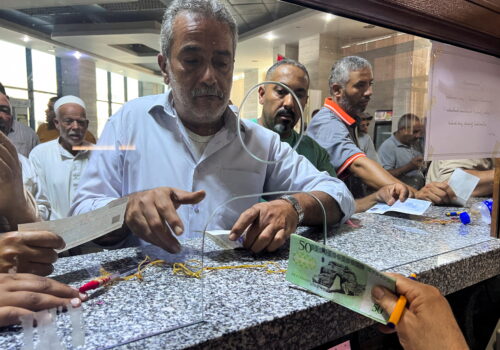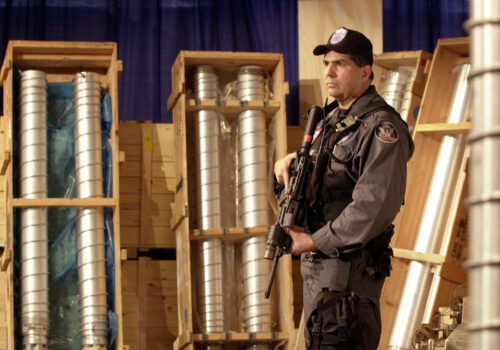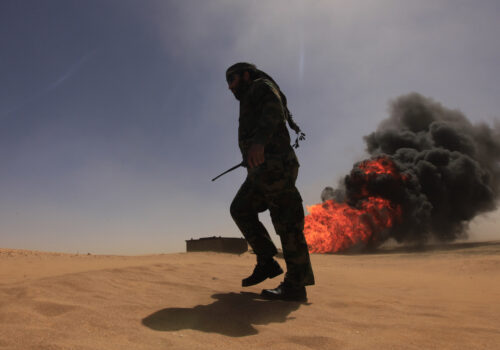The killing of Abdul Ghani al-Kikli may be a turning point for Libya
On May 12, 2025, Abdulghani al-Kikli, widely known as “Ghnewa”, the head of the Stability Support Apparatus (SSA), an entity affiliated with Libya’s Presidential Council, was killed in Tripoli. His death triggered armed clashes that resulted in six additional fatalities before the situation was declared “calm.”
According to Al Wasat, witnesses reported intense gunfire at the Tikbali military camp, located in southern Tripoli near the Abu Salim district—Ghnewa’s traditional stronghold—where streets were reportedly deserted during the fighting. Other sources based in Tripoli indicated that al-Kikli was killed in a targeted ambush, suggesting a deliberate effort to remove him from the country’s complex military landscape.
In the aftermath of the clashes, the Ministry of Defense under the Government of National Unity (GNU) announced that it had assumed “full” control over the Abu Salim area. By the morning of May 13, the ministry confirmed it had also secured all SSA headquarters and had issued directives to implement a broader plan aimed at restoring security and stability.
GNU Prime Minister Abdulhamid Dbeibah addressed the developments in a statement on X, extending congratulations to the Ministries of Interior and Defense, along with the army and police. He characterized the events as “a decisive step toward ending irregular groups,” asserting that the outcome “confirms that the legitimate institutions are capable of protecting the nation and preserving the dignity of its citizens.” He added that the operation reinforces the principle that “there is no place in Libya except for state institutions and no authority except that of the law.”
A push for power consolidation
Al-Kikli’s killing is reportedly part of a broader effort by these brigades to eliminate influential militia leaders and consolidate control over Tripoli under forces fully loyal to the GNU prime minister. According to Libyan sources, Hamza and Zoubi had been planning this campaign for some time. The original strategy was allegedly set to begin in April, targeting another major Tripoli militia—Abdulrauf Kara’s Special Deterrence Forces (SDF, or Radaa), which controls Mitiga Airport. However, the operation was delayed. The SDF was also the group responsible for kidnapping Hamza in 2023, an event that triggered one of the most severe outbreaks of violence in Tripoli since the October 2020 ceasefire.
Al-Kikli was targeted after escalating tensions by attacking the Libyan Post Telecommunications and Information Technology Company (LPTIC)—considered the most important state-owned enterprise in Libya after the National Oil Corporation (NOC). He and his men were accused of kidnapping and shooting the newly appointed chairman of the board, Salaheddin Elnajih, an appointee of Prime Minister Abdulhamid Dbeibah.
In early April, following Elnajih’s appointment, Prime Minister Dbeibah underscored “the importance of full and orderly disclosure of all revenues and profits of the company” and called for “adherence to financial transparency in order to strengthen the trust of the State and citizens in the performance of public institutions.” Elnajih, in turn, denounced what he described as a “systematic campaign targeting the company,” and affirmed his “full commitment to respecting the Prime Minister’s directives on disclosure and transparency.”
Both of the groups involved are nominally aligned with the GNU. The 444th Combat Brigade is commanded by Major General Mahmoud Hamza, appointed Director of Military Intelligence by Dbeibah in 2023. The 111th Reinforced Brigade, formerly known as the 301 Brigade, is led by Abdussalam al-Zoubi of Misrata. These two brigades were subsequently tasked with securing control over the contested area.
Al-Kikli in the crosshairs: Long brewing tensions
After the kidnapping, military authorities reportedly demanded the handover of those responsible. Al-Kikli’s refusal to comply elevated him to the top of the target list—not only for Zoubi and Dbeibah but also for several Misratan factions with increasing stakes in consolidating state authority.
Al-Kikli had shown little interest in pursuing a negotiated settlement. This led to the ambush: he was reportedly called in under the pretense of holding talks—something that had occurred numerous times in the past—but was instead killed.
Commenting on this operation, General Hamza stated: “Three hours were enough to complete a precise operation […] against the most brutal criminal forces in the country since 2011.”
This development must also be viewed within the context of persistent intra-Misratan rivalries, with Abdussalam al-Zoubi particularly focused on safeguarding his own position. Acting preemptively, General Hamza and Zoubi eliminated “Ghnewa”, seized all SSA bases, and consolidated their military presence.
Escalations and endurance: Looming questions on what’s to come
In the aftermath, questions remain over how the Special Deterrence Forces (SDF) and remnants of the SSA will respond.
There had been speculation about a possible negotiated deal. With Dbeibah, Hamza, and Zoubi currently holding the advantage, they may seek to pressure the SDF into accepting the terms of a potential surrender, possibly offering immunity or concessions in exchange for relinquishing control over Mitiga Airport.
However, according to images and reports emerging from Tripoli, the 444th Brigade launched an attack on Kara’s SDF on the evening of May 13, provoking a violent response from the Madkhalite-aligned militia.
This marks a significant development, highlighting a key distinction between the SDF and other Tripoli-based armed groups. The SDF is not a typical militia: it is a radical Islamist Madkhalite formation that follows the teachings of Saudi theologian Rabee al-Madkhali. Although Madkhalism is generally considered a politically quietist and ultraconservative branch of Salafism, the SDF has carved out a distinct identity, opposing both General Khalifa Haftar and Islamist groups such as the Muslim Brotherhood.
This ideological foundation has contributed to the SDF’s greater resilience and internal cohesion compared to more transactional or criminally driven militias. By contrast, the SSA under al-Kikli functioned primarily as a criminal network. With his killing, the group is likely to be replaced by a younger, still locally embedded but likely more radical figure. But in the short term, the SDF has been effectively sidelined.
Meanwhile, social media footage indicated the arrival of armed groups from other parts of western Libya—such as Zawiya and Warshefana—seemingly mobilizing in support of Kara’s faction. This type of fragmentation and shifting alliance-building is emblematic of intra-militia conflict dynamics in Libya since 2014.
After several hours of intense fighting, international agencies reported that a temporary truce had been reached. Whether it will hold remains uncertain.
The fate of Ghnewa’s fighters
Against this backdrop, another dimension warrants attention: While Tripoli’s militias may become politically irrelevant following the elimination of their leaders, they have historically played key roles in local territorial control. Though widely labeled as “criminal organizations,” these groups often functioned as de facto police forces, maintaining a tenuous form of order by deterring rival factions. In contrast, the forces led by General Hamza and Abdussalam al-Zoubi are highly militarized and not particularly suited for routine policing or neighborhood-level governance.
SIGN UP FOR THIS WEEK IN THE MIDEAST NEWSLETTER
A major question now concerns the fate of Ghnewa’s remaining fighters. Will they—especially those born and raised in Abu Salim, an area with deep symbolic resonance due to former Libyan leader Muammar Gaddafi’s notorious political prison—accept the new power structure? Or will they regroup under new, potentially more radical leadership and attempt to reassert control over their traditional strongholds?
The coming days will be critical in determining whether this assassination signals the beginning of a new chapter in Libya’s civil conflict or merely remains an isolated episode of political violence.
On Libyan social media, Ghnewa has also been accused of involvement in a broader network linked to Khalifa Haftar and the United Arab Emirates, allegedly working to undermine Tripoli’s leadership. However, such allegations are not new. During Haftar’s failed 2019 offensive against the capital, similar claims circulated—suggesting Ghnewa was preparing to flee with funds provided by Haftar—though these reports were never substantiated.
As previously noted, Dbeibah has expressed satisfaction with the recent military action. The assassination of Ghnewa and the dismantling of the SSA represent a significant step in his broader effort to centralize power. Yet while al-Kikli may have been the most powerful militia leader in Tripoli, extending this campaign to openly confront Kara’s SDF poses a much greater challenge, as demonstrated by the clashes on May 14.
Kara’s group, rooted in a Madkhalite Islamist ideology, appears to possess a more robust organizational structure than al-Kikli’s SSA, which more closely resembled a traditional criminal enterprise with limited ideological coherence. Moreover, recent events suggest the SDF has a greater capacity to mobilize support from other anti-Dbeibah elements across Tripolitania—something al-Kikli was unable to do, in part because the ambush that killed him came unexpectedly.
There is also a broader strategic implication for Dbeibah, who remains officially an interim leader. The removal of al-Kikli eliminates one of the final obstacles to General Hamza’s and his ally Zoubi’s rising influence.
Hamza, in particular, has recently expanded his political and diplomatic footprint, leading high-level military and intelligence delegations to Turkey, Algeria, and even Syria. These moves suggest he may now be positioning himself for a larger leadership role in Libya, potentially setting the stage for future tensions with his current political allies. Indeed, the web is full of images of Dbeibah alongside Ghnewa together, when they were close. As such, this strengthening of Hamza might represent a different, longer-term problem for Dbeibah.
Some regional observers have even speculated: could Hamza emerge as Libya’s own version of Ahmed al-Sharaa, the new Syrian leader? The contexts are very different, but in situations like these, direct control over armed groups can make a decisive difference. Dbeibah is leveraging both his networks and economic power to strengthen and permanently centralize his authority, but it is far from certain that this will be enough to comfortably stay in power.
Karim Mezran is the director of the North Africa Initiative and a resident senior fellow with the Rafik Hariri Center and Middle East Programs at the Atlantic Council, focusing on the processes of change in North Africa.
Dario Cristiani is a political risk consultant and an associate fellow at the Istituto Affari Internazionali global actors program in Rome. He is also a senior fellow at the German Marshall Fund, working on Italian foreign policy, the Mediterranean and global politics.
Further reading
Wed, Apr 16, 2025
Solving Libya’s economic collapse will require confrontation—not consensus
MENASource By Emadeddin Badi
If the status quo continues, the next phase of Libya’s crisis will not be quiet erosion. It will be public revolt.
Wed, Apr 30, 2025
From Tripoli to Tehran: Lessons from Libya in US-Iran nuclear talks
MENASource By
Twenty-one years later, the nuclear disarmament of Libya serves as a model for the United States in current nuclear negotiations with Iran.
Wed, Apr 2, 2025
Libya’s political deadlock endures. There is a case for Trump and Meloni to challenge the status quo.
MENASource By
The political crisis in Libya is one that the US and Italy may be uniquely postured, and incentivized, to quell.
Image: A member of the 444 Brigade of the Libyan Army, a unit serving the Government of National Unity (GNU) and Prime Minister Abdulhamid al-Dbeibah, stands guard at Abu Salim area, in Tripoli, Libya, May 13, 2025. REUTERS/Ayman al-Sahili



